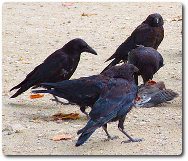Gerard Manley Hopkins, selected poems Contents
Commentary on Carrion Comfort
Addressing despair
The sonnet can be divided into four:
- in the octave
- in the sestet
- tercet 1: attempted answer to questions, to bring ‘cheer'
- tercet 2: more questions to himself in his struggle with God.
The sin of despair
In Catholic teaching, despair is often cited as the worst of the seven deadly sins, since it denies the possibility of God's grace. The poem opens dramatically with a series of negatives, to convince Hopkins  that he is NOT going down that path, whatever the cause of his depression or dark night of the soul.
that he is NOT going down that path, whatever the cause of his depression or dark night of the soul.
- ‘carrion' is dead meat, left lying around, which may be eaten by scavengers and birds such as vultures or carrion crows
- ‘despair' is addressed (or apostrophised) directly, as ‘carrion comfort'. That is, despair is seen as a negative comfort, associated with death, most obviously by suicide.
Positive negativity
The parallelism of line 2 (with its image of our body being knit together - used by Shakespeare among others) echoes the idea of negative ‘comfort':
- the negatives become doubled: ‘Not....cry I can no more'
- then re-expressed as the positive ‘I can'
- even if it is only ‘not choose not to be'
- where the double negatives return in a phrase echoing Hamlet's.
- even if it is only ‘not choose not to be'
Ironically, the creative process always creates ‘something', thus paradoxically negating negativity.
Questioning God
The second quatrain, addressed to God, questions why he is forcing Hopkins into such despair. Hopkins feels ‘frantic to avoid thee', as God seems to be giving him such a difficult time. This is a very different Hopkins to the one who celebrated service to God in The Windhover. He feels powerless against a God whose right foot can rock the ‘wring-world', a strong phrase suggesting a world emptied or wrung out.
Purification through suffering?
The first tercet begins as many sestets would: attempting to find a solution to the problem posed in the octave. The first answer proposed is that ‘my chaff might fly', an image suggesting that Hopkins' suffering has been for the purpose of purifying him. The image is that of winnowing cereals such as wheat, throwing it up in the air so that the lighter chaff is blown away and the heavier grains remain. For Hopkins, this has been an ongoing process, to which he has submitted as part of his discipline as a Jesuit (‘kissed the rod'), and up till now, he has been able to find moments of joy (‘would laugh, cheer').
A divided nature
Hopkins cannot quite reconcile himself to the process or see himself as submitted to it as he should be. He feels almost like two people- a feeling he bursts out with in the second tercet:
there is the person who worships Christ as ‘the hero', however hard the discipline
- also there is another person in himself who has struggled against God in the past
- the feeling at the end is that this second person is still struggling, even though Hopkins declares it to be ‘now done darkness'.
The sonnet finishes in a very open way. A solution has been suggested, but clearly does not really satisfy Hopkins, let alone us as readers.
- How does Hopkins see God in the sonnet?
- Find phrases and words that suggest his attitude.
- Make a list of the questions asked.
- How many are answered?
- To whom is the sestet really addressed?
- What has happened to ‘Despair'?
Recently Viewed
Related material
Scan and go
Scan on your mobile for direct link.